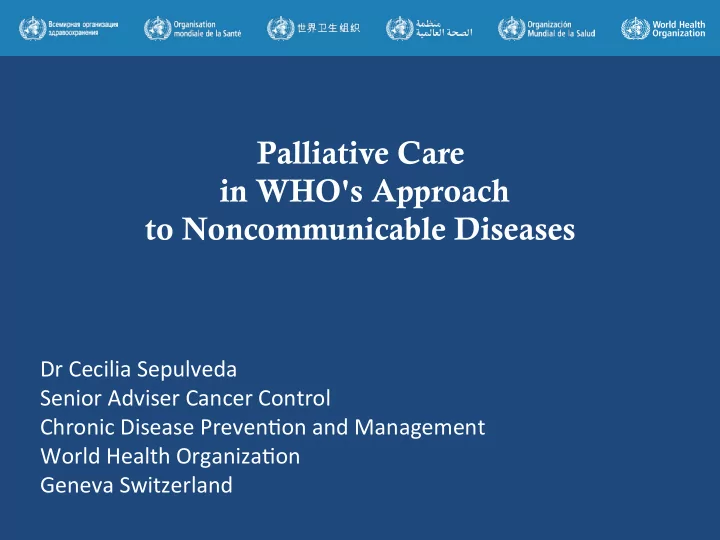

Palliative Care in WHO's Approach to Noncommunicable Diseases ¡ Dr ¡Cecilia ¡Sepulveda ¡ Senior ¡Adviser ¡Cancer ¡Control ¡ ¡ Chronic ¡Disease ¡Preven6on ¡and ¡Management ¡ World ¡Health ¡Organiza6on ¡ ¡ Geneva ¡Switzerland ¡ ¡ ¡
WHO's definition of palliative care Pallia%ve ¡care ¡is ¡an ¡approach ¡to ¡ ¡ • ¡improve ¡the ¡quality ¡of ¡life ¡of ¡pa%ents ¡and ¡their ¡ families ¡facing ¡life-‑limi%ng ¡illness, ¡ • ¡through ¡the ¡preven%on ¡and ¡relief ¡of ¡suffering ¡ ¡ • by ¡assessment ¡and ¡treatment ¡of ¡physical, ¡ psychosocial ¡and ¡spiritual ¡problems ¡ Source: National Cancer Control Programmes, Policies and Managerial Guidelines, 2 nd edition 2002
Comprehensive NCD Prevention and Contrrol Health-disease continuum Healthy Early Exposed to Advanced Terminal disease population risk factors disease disease � � Early Health Primary detection Promotion prevention � � Diagnosis � Treatment Palliative care
Major causes of death worldwide Source: GBD 2008
People in need of palliative care at the end of life 26.8 Million Children 0-14 Adults 15-59 10% 24% Adults 60+ 66% N ¡= ¡26 835 ¡386 Source: WHO estimates based on mortality (GBD 2008)
¡ Diseases ¡Requiring ¡Pallia6ve ¡Care ¡ ¡ at ¡the ¡End ¡of ¡Life ¡in ¡adults ¡ ¡ • Noncommunicable ¡Diseases ¡ ¡ ¡ – Cardiovascular ¡disease ¡ – Cancer ¡ – Chronic ¡lung ¡Disease ¡ – Diabetes ¡ – Chronic ¡kidney ¡/ ¡liver ¡disease ¡ – Neurological ¡and ¡degenera6ve ¡ ¡ – Musculoskeletal ¡ • Communicable ¡diseases ¡ – HIV/AIDS ¡ ¡ – TB ¡ – Hepa66s ¡B ¡and ¡C ¡ ¡ ¡ • Demen6a/ ¡Ageing ¡
Adults in need of palliative care at the end of life by diseases groups Parkinson ¡disease Alzheimer ¡ Nephritis ¡and ¡ Hepatitis ¡C ¡ 0.30% and ¡other ¡ nephrosis 0.17% Hepatiti Cirrhosis ¡of ¡the ¡ Rheumatoid ¡ dementias 2.08% s ¡B ¡ liver arthritis 1.49% 0.31% 2.29% 0.10% Tuberculosis Multiple ¡sclerosis 3.44% 0.05% Diabetes ¡mellitus 3.45% HIV/AIDS ¡ 3.72% Chronic ¡ obstructive ¡ pulmonary ¡ disease 9.05% Cardiovascular ¡ Malignant ¡ diseases neoplasms 47.62% 25.93% N ¡= ¡24 ¡260 ¡081 ¡ Source: WHO estimates based on mortality (GBD 2008)
Adults in need of palliative care at the end of life by World Bank income category Low income 9% High income 22% Upper middle income 16% Lower middle income 53% N ¡= ¡24 ¡260 ¡081 ¡ Source: WHO estimates based on mortality (GBD 2008)
Community ¡health ¡approach ¡to ¡pallia1ve ¡care ¡ Botswana, Ethiopia, India, Tanzania, Uganda, Zimbabwe, and others Needs of patients and caregivers § Accessibility to affordable ¡ medications (pain and other symptoms) § Financial support § Psychosocial and spiritual support § Cope with stigma § Adequate training fo r caregivers Source: WHO 2003
WHO's ¡global ¡road ¡map ¡on ¡NCDs ¡ Global Strategy for the Prevention and 2000 Control of Noncommunicable Diseases 2003 Global Strategy on Diet, Physical Activity and Health 2004 Action Plan 2008-2013 on the Global Strategy for the Prevention and Control of NCDs 2008 Global Strategy to Reduce the Harmful Use of Alcohol 2009 WHO Global Status Report on NCDs 2010 2011 Political Declaration on NCDs 2012+ Realizing ¡the ¡commitments ¡made ¡in ¡the ¡Poli1cal ¡Declara1on ¡
UN ¡Declara1on: ¡Specific ¡assignments ¡given ¡to ¡WHO ¡ • To reaffirm WHO's leadership and coordination role in promoting and monitoring global action against NCDs (13) § To intensify efforts to assist Member States in implementing, Global Strategy on NCDs and its Action Plan (45, 52, 54) § To work together with other UN Agencies in a coordinated manner to support national efforts (13) § To develop a comprehensive global monitoring framework and recommendations for a set of voluntary global targets (61, 62) § To provide input to Secretary-General's report to the UNGA on options for strengthening multisectoral action / partnership (64)
Palliative Care How to deliver ? • Large numbers of people in need • Great majority suffer from NCDs and live in lower resource settings • Innovative approaches (community based, PHC, partnerships) • Reduce demand / Public health approaches
Advance the public health approach to palliative care 1. Advocacy and awareness raising 2. Technical assistance to countries 3. Integration of palliative care in PHC 4. Access to pain relief 5. Dissemination of best practices 6. Reduce demand 7. Evaluation of models in resource constrained settings 8. Monitoring ( palliative care indicator)
Thank ¡you ¡
Recommend
More recommend